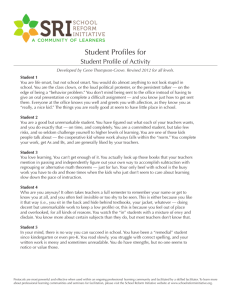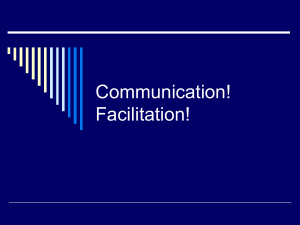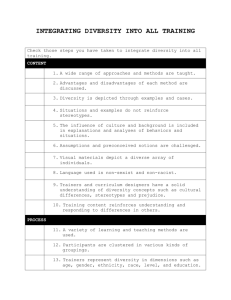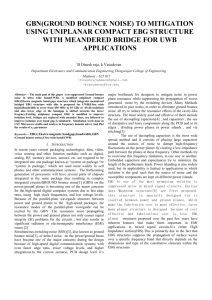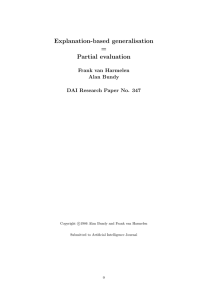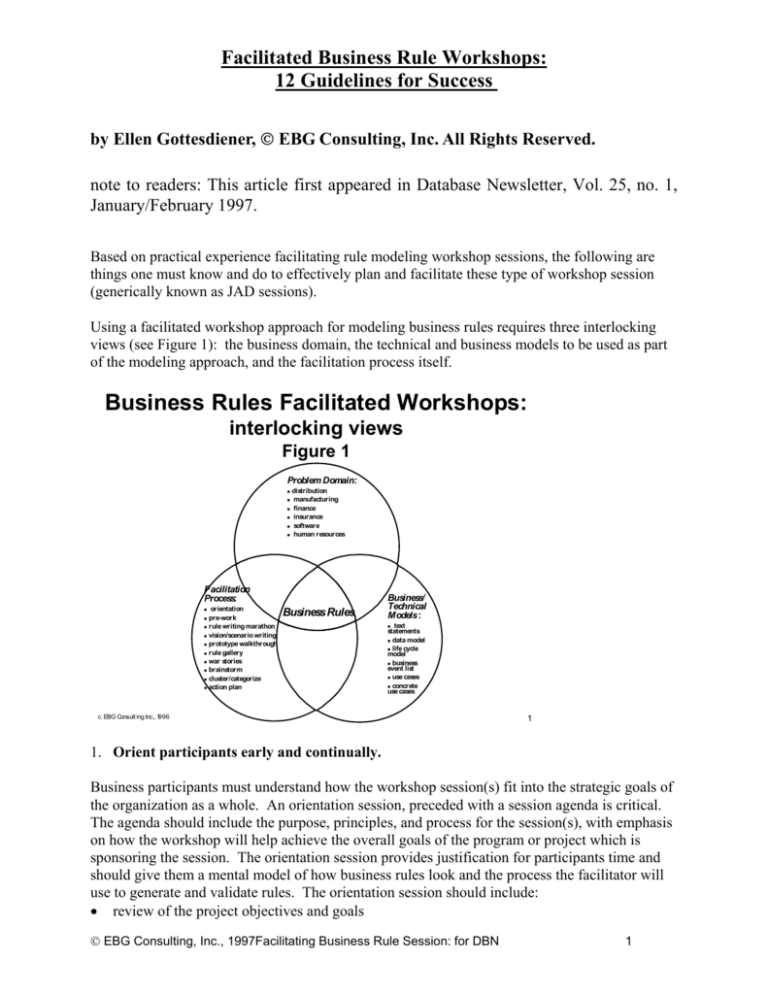
Facilitated Business Rule Workshops:
12 Guidelines for Success
by Ellen Gottesdiener, EBG Consulting, Inc. All Rights Reserved.
note to readers: This article first appeared in Database Newsletter, Vol. 25, no. 1,
January/February 1997.
Based on practical experience facilitating rule modeling workshop sessions, the following are
things one must know and do to effectively plan and facilitate these type of workshop session
(generically known as JAD sessions).
Using a facilitated workshop approach for modeling business rules requires three interlocking
views (see Figure 1): the business domain, the technical and business models to be used as part
of the modeling approach, and the facilitation process itself.
Business Rules Facilitated Workshops:
interlocking views
Figure 1
Problem Domain:
distribution
manufacturing
finance
insurance
software
human resources
Facilitation
Process:
orientation
pre-work
rule writing marathon
vision/scenario writing
prototype walkthrough
rule gallery
war stories
brainstorm
cluster/categorize
action plan
Business Rules
Business/
Technical
Models :
text
statements
data model
life cycle
model
business
event list
use cases
concrete
use cases
c. EBG Consult ing Inc., 1996
1
1. Orient participants early and continually.
Business participants must understand how the workshop session(s) fit into the strategic goals of
the organization as a whole. An orientation session, preceded with a session agenda is critical.
The agenda should include the purpose, principles, and process for the session(s), with emphasis
on how the workshop will help achieve the overall goals of the program or project which is
sponsoring the session. The orientation session provides justification for participants time and
should give them a mental model of how business rules look and the process the facilitator will
use to generate and validate rules. The orientation session should include:
• review of the project objectives and goals
EBG Consulting, Inc., 1997Facilitating Business Rule Session: for DBN
1
•
•
•
•
•
•
•
timeline for the project
facilitation session deliverables
overview to the facilitation modeling approach (see Figure 2)
examples of the models to be build during the session
overview of the facilitation process (see Table 1)
clarification of any prework to be done before the session
definition and examples (specific to the domain of the project at hand) of business rules
Business/Technical Models:
Facilitated Business Rules Workshop
Figure 2
Text Business
Rules
Concrete
Use
Cases
Business
Events
EntityRelationship
(data) Model
Entity Life
Cycles
c. EBG Consult ing Inc., 1996
2
xyz Business Rule Workshop
Overview to the Facilitation Process
Table 1
Workshop: task-oriented (create the deliverables)
Stick to the ground rules
Iterative (cross-checking and validating continually)
Teamwork required: as whole group and subteams
Make decisions: fix or eliminate suboptimal rules and establish optimal ones
Sponsor/steering checkpoints
Capture issues
Fast-paced
Fun allowed (encouraged!)
2.
Nail down definition early.
EBG Consulting, Inc., 1997Facilitating Business Rule Session: for DBN
2
Definitions (terms) are the foundation for all rules. They provide the substructure and scope of
the rule modeling effort. Do not let the group struggle with more complex rules like constraints
unless terms are agreed upon.
If the session has been well designed, participants will be included from all the business units
that use, make, modify and/or break business rules. This means that each will have their own
view of the definition and each view must evolve into one single agreed upon definition. For
example, in a company modeling business rules for manufacturing cosmetic products, what is a
package? The finished goods which is shipped to customers for sale or distribution? The
product in a ‘filled’ state such as in the delivery container without the outside box? The product
in a ‘finished’ state with any inserts such as instructions and promotional material? The group
must agree upon a single definition.
In larger firms, it is likely that a working list of definitions can be the starting point. Find
marketing literature, internal manuals, training material or any other documentation that will
provide a starting point. Let participants review these, find areas of agreement, disagreement,
and uncertainly in the definition. Ask questions: “Are there other terms like this?” “Does
[term] have different meaning in other [countries/departments/business units]?” “Are there other
terms inside this definition which we need to extract?” From there, the facilitator must move the
group towards a consensus definition. Consensus means: “I can live with it and support it”.
3. Bring rules to life.
Showing the rules in a simple prototype gives vitality to the rule modeling process. Writing text
rules and constructing visual models is a highly abstract, disconnected activity. Showing
participants a simple example of CRUDing (create, read, update, and delete) portions of the rules
which have been written allows them to visualize the rules in action. Further it has great value in
making good decisions about rules. For example, is location of the product part of the
uniqueness of a product? That is, if a product (in a manufacturing domain) has been made with
the same ingredients and same manufacturing process, but at a different location, is it the same
product? This is a real example of a rule which took many hours of effort to understand and
define. Showing a prototype of the rule with ‘yes’ or ‘no’ answers (it is necessary for
uniqueness or it is not necessary for uniqueness) enabled the participants to define the rule for
their company.
4. Have your tools at hand.
Tools of the facilitator in rule modeling sessions include:
• word processor for scribing the sessions
• data modeling tool
• tool for prototyping (such as Access or a product that will prototype and build the end
application, for example Usoft’s Usoft Developer or Vision Software’s Vision Builder)
• rules repository database (such as a home grown Access database) based on an appropriate
metamodel (see Figure 3 for a metamodel I have used)
EBG Consulting, Inc., 1997Facilitating Business Rule Session: for DBN
3
Business Rules xyz Project Metamodel
Figure 3
Owner
Non-Key Data
name
functionalArea
posed by
owned by
uses
xyz Project Entity
associates
Non-Key Data
entity
name
xyz Project Relationship
Non-Key Data
relationshipName
expressed in
used in
Business Rule
Non-Key Data
text
last
revision
date
comment
tests
Issue/Question
subject to Non-Key Data
text
Rule Type
classified by
Non-Key Data
definition
fact
derivation
constraint
implemented in
Use Case
Non-Key Data
text
System
Non-Key Data
systemName
systemAbbrev
Notes: enforced after validation of the rules:
- each business rule classified as ‘definition’ must have an xyz entity
- each business rule classified as ‘fact’ must have an xyz relationship
c. EBG Consult ing Inc., 1996
c. EBG Consulting, Inc., 1996
3
In each case, the facilitator must insure that knowledgeable and trained individuals are available
to use the tool during the sessions. Be prepared to produce the products in the tool before and/or
after session hours. For example, in a recent series of sessions, our rules repository contents
were printed out prior to a day’s sessions. The rules at times were sorted differently as well. For
example, we sorted by rules that had questions, rules by type (definitions, facts, constraints,
derivations), rules by object clusters (e.g. product, specification, container, market, customer,
etc.).
5. Iterate the group process.
Design the group processes to permit human thinking to iterate between the big picture and the
minute details and between model types that have orthogonal views. This assists in evolving the
end product - agreed upon business rules and rule models - in a more natural way. It also allows
different individuals to cross-check a rule at different points in the modeling process.
For example, I have used an approach in which the participants spend a half day writing text
rules and in the second half day, they generate business events in scope. When the group is
larger than four, it helps to create sub-teams to write, in mini-marathons, rules for a cluster of
domain terms. They then share their findings with the whole group using either a walkthrough
or a ‘gallery’ (each sub-team posts their products then all sub-teams rotate from model to model
while recording their questions and comments), or a combination of these approaches. This
allows the sub-teams to get validation and/or challenges for their rules. After the whole group
has convened and shared their models, each subteam will then need to fix them back in their subteams.
One full iteration will cycle from rule writing in sub-teams followed by returning the whole
group to review all the rules and then going back into sub-teams for further revision and
refinement based on the whole group’s feedback. After each of these cycle, give participants a
mental and physical break. Generating business events in scope allows them to move their focus
off the task of writing rules yet maintain an orthogonal view of those same rules. Latter in the
EBG Consulting, Inc., 1997Facilitating Business Rule Session: for DBN
4
workshop, the business events should be used to cross-check the completeness of the business
rules.
Similar iterations are : working on business event clusters then conducting a data model
walkthrough; doing data model design then writting text rules; brainstorming object (or data)
lifecycles then generating concrete use cases; writing attribute rules then walking through
relationship rules; sharing ‘as is’ war stories then writing or sharing ‘to be’ scenarios.
6. “From Torture Comes Knowledge”
This is a direct quote, posted as the title of a portion of a data model, from one sub-team halfway through a 7-day rules modeling workshop. Modeling business rules is very hard work,
requiring our business partners to learn a lot about the business (that is, hear other points of
view), to test their assumptions, and to try out new business and technical models. In the session
just noted, they began to understand the real meaning of the business domain they were
modeling after using a portion of a data model in conjunction with text rule statements they had
written in a prior sub-team exercise. These discoveries were shared and celebrated throughout
the facilitated sessions. Many participants felt their brain had been stretched as never before but
that in the end, they had learned a lot about their own business.
Do not let the models become torture themselves. Natural language statements are the core
deliverable of rule modeling sessions, supplemented by a data model to accelerate prototyping
and application development as well as to assist in rule validation. The other models (event, use
case, concrete use case, life cycle) all feed and validate the text rules.
Three days into the aforementioned session, I conducted a mini tutorial on data models. The
data analyst on the project then followed this tutorial with a walkthrough of the data model
representation of their rules which he was developing while they worked on the rules. At that
point, after several days of hard work modeling rules as text, the group was ready to use the data
model as a tool, in conjunction with a system prototype. They soon began using the terms
‘associative entity’, ‘attributes’, and ‘cardinality’ as shorthand during discussions. One
participant (who in the past avoided any systems-like activities) asked a question about a subteam assignment, “When we’re really smokin’ with cross-feet, should we….?” A comfort level
evolved with data models.
In follow-up sessions, the participants became hung up on the data model semantics rather than
the clarification of business rules. Therefore beware the activity of data modeling as an end in
itself. It must be emphasized to the business participants that the data model’s purpose in the
workshop is as a tool to test and validate the rules and that it only partially expresses a subset of
the business rules.
7. Be prepared to battle with scope.
As experienced business and technical facilitators know, scope issues and questions always
emerge during sessions. Preparation means having the scope pre-defined before the session(s)
start, including enumeration of what is in and what is out of scope. Ask if the concern is scope.
Double check with participants: even though this has been defined as out of scope, does it pose
a risk to our goals to not address this issue? If so, add the concern or question to the “Issues”
area in the session workshop room. Return to it at an appropriate time during the workshop.
EBG Consulting, Inc., 1997Facilitating Business Rule Session: for DBN
5
When revisiting the issues around scope, the group will discover that some of these issues will
have been resolved in the work done already. Other issues need to be assigned and addressed
outside of the workshop session, while still others can be tackled with the whole group. A savvy
facilitator will keep on eye on the issues and periodically test, remove, categorize, cluster, and
re-cluster issues with the whole group.
8. Make participates speak using the meaning behind the language of the business.
Business participants often talk in codes. The codes vary depending on each functional area in
the business. Codes mask business meaning and obfuscate business rules. The facilitator must
enforce a session rule: do not speak in codes.
In one series of sessions, the term ‘item’ was used by all participants to mean the product at
different lifecycle stages. The item codes were dependent on where, how, and when the product
was tracked. It blocked effective rule modeling. Using a big (rubber) hammer when the
meaningless term ‘item’ was used, quickly and humorously turned the discussion into a more
meaningful exchange.
9. Conduct rule writing tutorials.
Despite the elegantly simple semantics of writing a business rule, provide participants with a
jump start. First, assign writing some rules (after a brief overview in both the session agenda
package and the orientation session) as a pre-work assignment. This gets participants thinking
about elementary rules and also demonstrates how paradoxically simple yet difficult it is to write
business rules. During the rule modeling workshop itself, the facilitator should lead the
participants through a tutorial on writing business rules. Provide ‘rules for modeling rules’ (see
Table 2 for a sampler), then practice together writing some rules. In larger groups when subteams of rule writing are used, be sure to assigned rule-keeper roles
Rules for Modeling Rules:
Table 2
Modeling Rule
1. Use/reuse existing definitions.
2. If a new definitions is needed, write it on
a half-sheet before using it to describe
another rule..
3. Use meaningful, precise verbs to connect
definitions (the category called ‘facts’).
4. Use standard expressions for constraint
business rules like:
5. Use standard expressions for derivation
business rules like:
Comments
All definitions are captures in the rule repository
Share any the new definition(s) with the entire
group; obtain consensus on the definition and then
store it in the repository
Avoid verbs like “has”, “uses”, “relates to”,
“associates to”, “consists of”. Strive for precise
verbs which convey the business intent.
Examples include:
• must
• must not
• only if
• only when
• must have at least one/more than one/only one
Examples include:
• x is calculated from/summed from
EBG Consulting, Inc., 1997Facilitating Business Rule Session: for DBN
6
• when x is true, then y is also true (or not true)
• z is automatically considered a k
• z is inferred from n
• when n is true then than g is considered to be a
t
if x then it also means y
Add them to workshop ground rules.
6. Add new rules for writing rules when it
makes sense. Bring them to the whole
group for understanding and agreement.
10. “Why are we doing this, again please?”
Despite a solid session orientation, deep in the facilitation process participants will continually
ask “why are we doing this stuff?”. This is particularly evident when in large group sessions,
many points of view about a rule needs to be debated. The facilitator needs to be sensitive to this
and periodically review the strategy (see figure 4). Conversely, this question arises as minute
details about a particular rule is being defined. Participants can easily get lost in the details of
writing a rule and forget what has been accomplished and where the group needs to go. The
facilitator will then need to map out tasks along the way (see Table 3 for an example of one I
have used).
Business Rules Strategy
Figure 4
•definition
•fact
(connections)
Business Rules
Text
enforced in
•definition
•fact
(connections)
•constraint
•derivation
xyz
Database
xyz
Data Model
Rules
xyz
Rule Enforcement
Software Programs
•constraint
•derivation
Implementation/
design
c. EBG Consult ing Inc., 1996
4
Set the stage for this ongoing question by having participants share the ‘as is’ situation (war
stories about how difficult, unproductive, and costly life is without standardized and managed
business rules). This has the added benefit of quickly building camaraderie amongst the
participants.
EBG Consulting, Inc., 1997Facilitating Business Rule Session: for DBN
7
Balance this view with a vision of the ‘to be’ world when rules have been standardized. Permit
participants to image, in an individual writing or group writing exercise, what that portion of the
business will be like once business rules have been defined and stewardship established.
Participants are delighted by their own and each other’s visions and sometimes pleasantly
surprised about the business benefits that will emerge with a rule managed environment. These
exercises in facilitated sessions reinforce this fact about business rules: structure permits
flexibility.
Workshop Road Map:
Tasks to Fulfill Strategy (reference Figure 4)
Table 3
Strategy
Transitioning from Business
Rule Text to Data Model
Task
• assign attributes to an entity
• know if entities combine to also be kinds of other entities - a
term describes a sub-set of another term:-e.g. “purchased
material” is a “manufactured material”)
• define attributes which distinguish sub-set entities
• assign each attribute as Mandatory or Optional
• validate connections as Mandatory or Optional; One or Many
• find the allowable values for certain attributes
Transitioning from Business
Rule Text to Business Rule
•
clean up questions
•
•
add more rules (events help)
•
test the data model with these rules: (be sure all the
information is there to enforce the rule)
•
•
test with events
assign owner
• assign status
• cross-check: definitions must exist for terms used in other
rules
Transitioning from Business
Rule to Data Model
test with scenarios (concrete use cases)
11. Get the right participants.
It is imperative, for any type of facilitated workshop, to have the “right” participants. In the case
of business rule modeling workshops, the facilitator must insure that the right combinations of
business experts are participating. This includes a mix of people in both their depth and breadth
of knowledge and experience with the business domain. There must be people who understand
the cross-functional aspects of the business domain. It should also include individuals who have
experience in the business domain outside the company itself. These people will intuitively be
able to ‘think out of the box’ about business rules and helpful to others by sharing their external
perspective.
EBG Consulting, Inc., 1997Facilitating Business Rule Session: for DBN
8
Lining up the right participants is no small task. The facilitator must work closely with the
project manager to validate that the participants are the right one, and that an appropriate mix of
skills, knowledge and personalities are present. The end result of this preparation is symbolic of
the organization’s commitment to the workshop goals.
12. Use solid facilitation process skills.
The facilitator’s job during the workshop is to manage the group process by focusing the group
on their common problem using a viable approach, getting everyone to share and by building
trust. The skilled facilitator knows how to exploit the power of groups, and yet appropriately
respect that power. This respects yields a well-prepared facilitator who understands the
criticality of preparation, planning, tools, and follow up.
The facilitator must focus and operate on many levels: individual participants, the whole
group’s energy, the content of the models, the context for the modeling activity, the problem
domain, the capture of group memory in coordination with the scribe(s), the need for shifting
perspectives, and the need for mental and physical breaks.
Remember the three interlocking views (Figure 1). Understanding the business and technical
models and the business domain alone can be a recipe for disaster without skilled, experienced
facilitation. The facilitator will draw on many skills: organizing, summarizing, listening,
asking, questioning and training. The facilitator draws from a tool box of techniques which vary
depending on the category of facilitation: creativity, decision making, planning, design,
problem-solving, team building, strategizing.
A rule modeling session draws on most of these categories, with the primary category being
design. The skilled facilitator provides structure to design activities. For example, if the
problem domain is large and there are many participants (try to limit it to 12 if at all possible),
then sub-teams will be necessary to get some of the rule modeling work done. The whole group
is needed during brainstorm, categorizing, validation and walkthrough activities. When subteams are used, a structure must be provided since the facilitator cannot manage each team for
the whole time. Provide clear roles and responsibilities for these activities (see Table 4 for an
example.).
Roles for Modeling Rules in Sub-teams:
Table 4
Role
Hammer person (keeper of the •
rules for modeling rules) per
sub-team
•
Rule Keeper person per subteam
Responsibilities
Use the 5 minute rule; create a ‘red area’ (tool I use for
visually displaying Issues) for issues and/or, questions that
are holding you up.
Insure your team sticks to the ‘section’ of the Data Model
assigned to you
• Insure your team ‘thinks xxx-co.’ - our future vision of the
company once the rules have been standardized and
stewarded
Insure the integrity of the rules as expressed on the text Rules
List AND insure the cross-check against the Data Model as
EBG Consulting, Inc., 1997Facilitating Business Rule Session: for DBN
9
follows:
• Each connection (for each direction of the connection) must
have at least one rule on the Rule List
• Each term used in a rule on the Rule List that applies to
your ‘section’ of the data model must be defined as a rule on
the Rule List.
• Extract all the constraint and derivation types of rules from
the Rule List that apply to your ‘section’ and validate they
are correct
• Any question text you write for a rule will be assigned to
you, unless you otherwise specify a team member
• Each rule you add will be assigned to you unless otherwise
specified
Data Modeler Keeper person
Insure your sub-team has visually depicted your ‘section’ of the
per sub-team
Data Model showing all appropriate:
• subtype
• connection with the connection name (fact) on the line
• list all attributes on your core Entity (e.g. Sellable Product,
Market, Account, etc.) that are mandatory for uniqueness
• write on the portion of the model the rule # to which it
applies - all connections (both directions and entity definitions)
Events Keeper person per sub- Extract business events which may be relevant to your ‘section’
team
of the Data Model. Walk through each to test if rules exist to
handle this event on both the data model and the Rules List.
Conclusion on Using a Facilitated Workshop Approach
The facilitated approach is an excellent one for business rule modeling. It is an superb forum for
converting abstract thoughts, opinions, and ideas into consensual agreements and decisions for
business action. Because it requires knowledgeable and willing business participants, having
obtained them as participants in an intensive business rules workshop communicates that there is
senior business support for effort. The workshop will accelerate the timeframe needed to deliver
business rules. The rules will more likely be correct, having been tested in numerous ways by all
the participants during the workshop. Additionally, the overall project will have committed
advocates in those business participants who have a stake in the implementation and
management of the business rules.
EBG Consulting, Inc., 1997Facilitating Business Rule Session: for DBN
10



